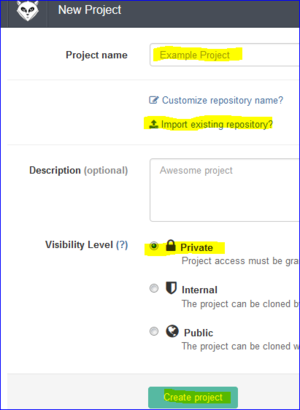Difference between revisions of "Eclipse & Gitlab Tutorial"
(→Setup Gitlab Profile) |
(→Setup Gitlab Profile) |
||
| Line 17: | Line 17: | ||
* Click on '''Create Project''' | * Click on '''Create Project''' | ||
| − | | [[ | + | | [[Image:tutorial_gitlab_newproject.PNG|left|300px]] |
|} | |} | ||
Revision as of 18:44, 20 June 2014
This tutorial shows how to use source control software (GIT) from within Eclipse. There are several hosts that can provide GIT services, and Gitlab appears to be a great one! In this tutorial, I will show you how to CLONE my LPC project for the SJ-One board, and you can use the knowledge to work on your own GIT projects.
Contents
Setup Gitlab Profile
|
Clone GIT Repository
In this section, we will bring-in the Gitlab project in your computer through Eclipse. Eclipse uses TEAM as a Git client.
- Copy your Git Project HTTPS URL
- This is not my project's URL, but YOUR project's URL
- In Eclipse, make sure that you have the "Git Repositories" view available
- Go to Window --> Show View --> Other
- Click on Git --> Git Repositories
- Now in the Git window, click on Clone a Git repository
- Your copied Git repository will auto-fill
- Type your username and password
- Choose "Store in Secure Store"
- Click Next, and then Next again
- At this window, you will see Finish, but before you click, use correct destination directory
- Choose your "workspace" directory, such as SJSU_Dev/projects
- Choose the same project folder, "lpc1758_teamx"
- Click Finish, and wait a few minutes for Eclipse to bring-in the Gitlab project
- Your project will show under "Git Repositories" section.
Import Gitlab project to Eclipse
If you cloned my LPC project, the final step is to IMPORT the project in Eclipse. As of now (June 2014), Eclipse has a bug where you cannot use "Import Project" while adding the Git project in the previous section, so we will do this manually.
Note that if you want to add multiple LPC projects at this GIT repository, just copy and paste the folders of your projects here, and then IMPORT individual projects. The next section shows you how to COMMIT and PUSH your changes if you have added subfolders of multiple projects at this directory.
- In the Project Explorer section, right click and choose "Import Project"
- Under General, pick Existing Projects into Workspace
- Click Next and browse the root directory of your project and click Finish
Check-in code to Gitlab
After you have a project in Eclipse that is connected to Gitlab, you can now perform changes, and check-in the source code. Making changes is as easy as editing a file. Eclipse will inform you which files have changed by using icons next to the files or folders.
- Make any changes
- Right click on your project and click on Team --> Commit
- Type in your Gitlab username and password if needed.
- First line should be the heading or title of your commit, ie: "Fix bugxyz"
- Next lines can contain details of your changes
- You can either "Commit" only, or "Commit and Push"
- "Commit" will not push your changes, it is like a local commit.
- "Commit and push" will push changes to the Gitlab repository.
- Go to Gitlab and you will see your pushed changes.
Other helpful hints:
- If others' have checked-in source code, you can go to Team and Pull to pull-in their changes
- Do this often to continuously integrate other people's code in yours.
- By browsing to Team --> Synchronize Workspace, you can see your changes.
